2. 湿地生态功能与恢复北京市重点实验室, 100091, 北京;
3. 北京林业大学, 100083, 北京
中国水土保持科学  2019, Vol. 17 2019, Vol. 17  Issue (1): 102-108. DOI: 10.16843/j.sswc.2019.01.014 Issue (1): 102-108. DOI: 10.16843/j.sswc.2019.01.014 |
海河流域人口众多,大中城市密集,人水矛盾十分突出,地区水资源缺乏十分严重。其山区部分是整个流域的主要集水区域,对海河流域山区水文过程变化的分析对流域水资源规划与管理具有重要的意义。
近些年来,各国学者在河川径流归因分析和气候变化影响评价等方面开始了大量研究[1-3]。水文模型是流域水文过程分析中应用最为广泛的方法,主要有分布式水文模型与集总式水文模型2类。分布式水文模型是流域水文过程研究中应用最为广泛的研究方法[4-6],但由于参数众多,在参数率定等方面需要耗费大量精力[7]。集总式概念模型主要利用一些相关的理论定律和理论假设来分析流域水文过程机理,相比分布式水文模型更为简便易行。以Budyko假设为基础的流域水热耦合平衡模型是集总式概念模型的典型代表,也是研究气候变化对流域水文过程影响应用最为广泛的理论模型之一[8-9]。
本研究以海河流域山区为研究区域,分别应用基于Budyko假设的概念模型和双累积曲线法分析气候变化和人类活动对研究区径流变化的影响,明确各自的影响量和贡献率,旨在为海河流域水资源管理提供参考。
1 研究区概况基于海河流域水资源三级分区以及流域数字高程(DEM)概况,本研究划分出海河山区的主要范围(图 1),能够覆盖流域范围内的所有山区部分。研究区域处于E 111°57′~119°35′和N 35°3′~42°43′之间,海拔0~3 000 m,总面积约为18.64万km2。海河流域山区大陆性季风气候明显,年降水约500 mm左右,冬季寒冷少雪,春季风大干燥,夏季湿润多雨,秋季干爽雨少。研究区主要土地利用类型为林地与草地,森林类型主要为针阔混交林与落叶阔叶林,主要的土壤类型为褐土和棕壤,土层一般较薄,深度多不足1 m。
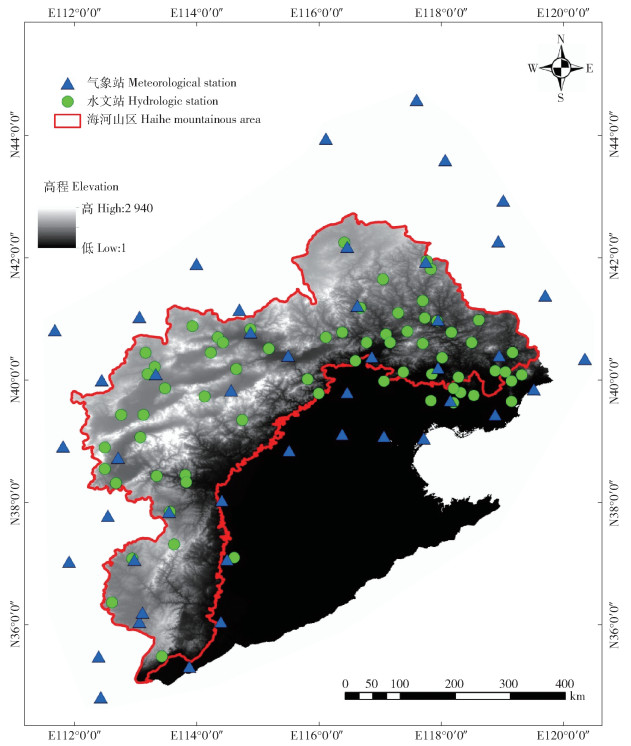
|
图 1 海河流域山区位置及概况 Fig. 1 The location of Haihe mountainous area |
本研究所需流域水文过程数据主要来源于中国水文年鉴海河流域卷,各水文站位置如图 1所示,数据时间序列为1957—2000年。气象相关数据均来源于中国气象科学数据共享服务网(http://cdc.cma.gov.cn/),各气象站位置如图 1所示,数据内容包括降水量、蒸发量、相对湿度、气温、气压、日照时间、地面辐射、风向风速等。DEM数据主要提取于中国90 m分辨率数字高程模型数据集。
2.2 计算模型Budyko(1974)[10]对流域尺度上的水热耦合关系提出一个假设理论,认为流域多年平均蒸散发受降水和潜在蒸散发影响,可简单地表达为
| $ \frac{{{E}_{\text{T}}}}{P}=f\left( {{E}_{\text{P}}}/P \right)=f\left( \phi \right)。$ | (1) |
式中:ET为流域实际蒸散发量,mm;P为降水量,mm;EP为流域潜在蒸散发量;ϕ为干燥度指数,ϕ=EP/P。
Milly等[11]基于Budyko假设理论,提出气候变化导致的径流变化量
| $ \Delta Q\text{climate=}\beta \Delta \mathit{P+}\gamma \Delta {{\mathit{E}}_{\text{P}}}; $ | (2) |
| $ \beta =1-\mathit{f}\left( \phi \right)+\mathit{\phi }f'\left( \phi \right); $ | (3) |
| $ \gamma =-f'\left( \phi \right)。$ | (4) |
式中:ΔP和ΔEP分别为降水和潜在蒸散发的变化量;β和γ为2个量纲为1的常数,分别表示单位降水和潜在蒸散发的变化量所引起的流域径流变化量。
在f(ϕ)的各种表达式中,Zhang等[12]以全球250个流域为样本组进行模拟,对公式(3)中的函数f进行具体化,提出了一个简单的双参数模型:
| $ \frac{{{E}_{T}}}{P}=\frac{1+\omega \frac{{{\mathit{E}}_{\mathit{P}}}}{P}}{1+\omega \frac{{{\mathit{E}}_{\mathit{P}}}}{P}+{{\left( \frac{{{\mathit{E}}_{\mathit{P}}}}{P} \right)}^{-1}}}=\mathit{f}\left( \phi \right)=\frac{1+\omega \phi }{1+\omega \phi +{{\phi }^{-1}}} $ | (5) |
式中ω为一量纲为1的参数,Zhang等[12]在文章中提出ω的建议值,即林地为2.0,草地与耕地为0.5。
应用该模型,则β和γ(公式(3)和(4))的计算公式为
| $ \beta \text{=}\frac{1+2\phi +3\omega {{\phi }^{2}}}{{{\left( 1+\phi +\omega {{\phi }^{2}} \right)}^{2}}}。$ | (6) |
| $ \gamma \text{=}-\frac{1+2\omega \phi }{{{\left( 1+\phi +\omega {{\phi }^{2}} \right)}^{2}}}。$ | (7) |
笔者采用双累积曲线的方法来计算人类活动对流域径流的影响。其基本的步骤为:对基准期逐年累积降水量∑ P和逐年累积径流量∑ Q 2列数据进行线性回归,拟合两者之间的关系方程
| $ \sum{Q=a\sum{P+b}}。$ | (8) |
将变化期的∑ P代入公式中求得变化期的累积径流深模拟值∑ Q′,基于模拟值∑ Q′反推得到逐年的径流深模拟值Q′,则变化期径流量的实测值与模拟值的平均值的差即为人类活动对流域径流的影响。
3 结果与分析 3.1 流域水文过程及气候年际变化特征研究区1957—2000年逐年降水、径流、气温及潜在蒸散发量变化(图 2)显示,海河流域山区降水(P)、径流(Q)和潜在蒸散发量(EP)均呈下降趋势,而气温(T)为上升的趋势。应用Mann-Kendall趋势检验分析方法,对上述水文气象因子进行趋势检验,P、Q、T、EP的统计量Z值分别为-1.47、-2.73、3.99、-2.38,结果表明:除降水外,各因子的统计量Z值的绝对值|Z|均>1.96,这说明研究区气候变化达到显著水平。
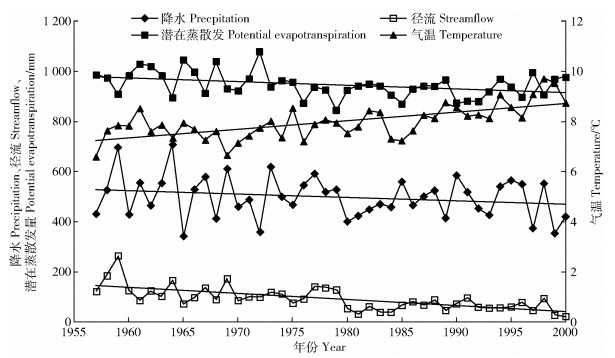
|
图 2 海河流域山区水文及气候演变规律 Fig. 2 The evolution of hydrology and climate in Haihe mountainous area |
研究区逐年径流量Mann-Kendall突变检验分析结果如图 3所示,结果表明,统计值UF和UB2条曲线在1980年出现交叉点,且位于临界线(0.05显著水平的置信区间Y=±1.96)内,表明研究区径流数据序列在1980年发生突变。
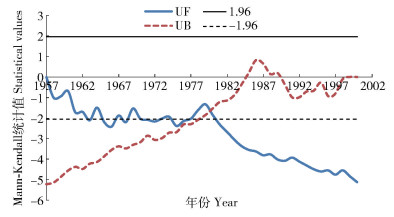
|
图 3 海河流域山区年径流量Mann-Kendall突变检验 Fig. 3 Mann-Kendall mutation test of annual streamflow in Haihe mountainous area |
基于对径流的Mann-kendall突变分析,将突变前后2段研究时段划分为基准期(1957—1979)和变化期(1980—2000)。图 4表明了不同时期的径流量对比,研究区基准期的多年平均径流量为115.12 mm,变化期的多年平均径流量为69.94 mm,径流总变化量ΔQ为减少了45.18 mm;基准期年平均降水量为518.88 mm,变化期年平均降水量为477.68 mm,降水量的变化量ΔP为41.20 mm;基准期年平均潜在蒸散发量为962.84 mm,变化期年平均潜在蒸散发量为930.47 mm,ΔEP为32.37 mm。
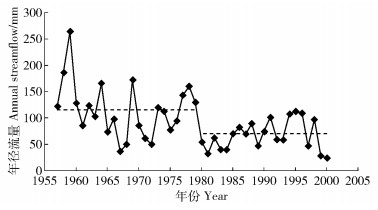
|
图 4 海河流域山区不同时期多年平均径流量对比 Fig. 4 Comparison of streamflow in different periods in Haihe mountainous area |
基于研究区多年平均降水量与潜在蒸散发量,计算可得研究区干燥度指数值ϕ,依据ω值的参考值,代入公式(6)与公式(7)中,通过计算,得到研究区β值约为0.338 3,γ值约为-0.094 4。
对研究区2个研究时段水文要素对比结果表明,变化期(1980—2000年)的降水量变化量ΔP为41.20 mm,而潜在蒸散发量ΔEP为32.37 mm;因此,经计算可得,ΔQP为减少13.94 mm,ΔQEp为增加3.05 mm,即气候变化导致的径流变化量ΔQclimate为10.89 mm,其中降水的贡献率为82.05%,潜在蒸散发的贡献率为17.95%。
3.3 人类活动对区域径流的影响基于海河上游山区长时间序列的逐年降水及径流数据,对降水和径流2个序列变量进行双累积曲线分析,结果如图 5所示。
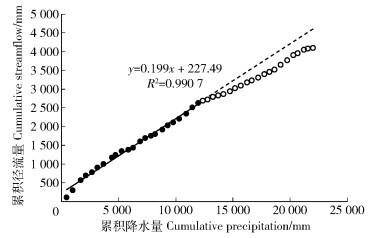
|
图 5 海河山区降水量与径流量双累计曲线图 Fig. 5 Cumulative curves of precipitation and streamflow in Haihe mountainous area |
图中表明,研究区累积降水量与累积径流量之间的相关关系在1979年发生明显的变化,表明在1979年后人类活动开始对流域径流有明显的影响,而依据双累积曲线分析方法,1979年后的累积降水量与累积径流量的拟合直线与1957—1979年的拟合直线间的变化反映了人类活动的影响量。结果表明,1980—2000实测年平均径流量Q为65.55 mm,而反推结果表明,无人类活动影响下的模拟逐年径流量Q′为99.42 mm,由此可知,人类活动导致的径流变化量ΔQhuman为33.87 mm。
3.4 贡献率分析在上述研究中,ΔQhuman为33.87 mm,ΔQclimate为10.89 mm,因此ΔQclimate+ΔQhuman为44.76 mm,而实际ΔQ为45.18 mm,2个值之间的差为模拟的误差值0.42 mm,误差率仅为0.92%,结果表明本研究的计算结果误差较小。对研究区气候变化与人类活动对流域径流的的影响量及贡献率的结果如表 1所示,结果表明,流域径流变化过程中,人类活动影响的贡献率为74.97%,远远大于气候变化的影响24.11%,这说明,海河上游山区径流减少的主要因素是人类活动的影响。
| 表 1 海河山区气候变化与人类活动对流域径流影响的贡献率 Tab. 1 The contribution rate of climate change and human activity on streamflowin Haihe mountainous area |
本研究以海河流域山区部分为研究区域,分别对研究区径流年际变化过程中气候变化和人类活动的影响进行分析,研究结论如下。
1) 研究区降水、径流及潜在蒸散发均存在明显的下降趋势,气温存在明显的上升趋势,区域水文过程及气候变化明显。流域径流突变分析结果表明,其在1980年发生突变。
2) 研究区变化期(1980—2000)流域径流相比基准期(1957—1979)减少45.18 mm,其中气候变化的影响量为10.89 mm,其贡献率为24.11%。
3) 人类活动是影响海河山区流域径流变化的主要因素,其对研究区径流变化的影响量为33.87 mm,贡献率为74.97%。
众多研究均表明,影响流域径流的因素可以笼统的概况为气候变化与人类活动2方面[13-15]。气候变化通过气温、辐射、风速等的变化改变了水资源的循环及其分布,同时对干旱洪涝极端水文事件产生直接影响[16],对流域生态系统的结构和功能产生深远影响[17]。基于Budyko假设的流域水热耦合平衡模型是水热平衡的典型代表,也是研究气候变化对流域水文过程影响应用最为广泛的理论基础之一[8-9]。由Budyko假设理论可知,气候变化对流域径流的影响主要是由于降水和潜在蒸散发的变化引起的[11];因此,本研究基于降水与潜在蒸散发的分析来反映气候变化对流域径流的影响。
人类活动通过改变下垫面类型从而影响区域水循环过程,其对流域径流的影响有众多因素,如土地利用变化、水利工程、水资源开发等等均有明显的影响,海河流域是受人类活动影响最为严重的区域之一。而大多数研究均表明,人类活动对流域径流的影响要远大于气候变化的影响[18],笔者的结果也表明,海河山区流域径流变化过程中,气候变化的贡献率仅为24.11%,而人类活动的贡献率则达74.97%。这主要与研究区水利设施兴建有关,海河流域山区现已修大型水库33座,总库容249亿m3,控制山区面积的85%,众多水库等水利设施的建设对流域径流产生明显的影响。
| [1] |
林凯荣, 何艳虎, 陈晓宏. 气候变化及人类活动对东江流域径流影响的贡献分解研究[J].
水利学报, 2012, 43(11): 1312.
LIN Kairong, HE Yanhu, CHEN Xiaohong. Identifying the quantitative effect of climate change and human activity on runoff in the Dongjiang River basin[J]. Journal of Hydraulic Engineering, 2012, 43(11): 1312. |
| [2] |
刘春蓁, 占车生, 夏军, 等. 关于气候变化与人类活动对径流影响研究的评述[J].
水利学报, 2014, 45(4): 379.
LIU Chunzhen, ZHAN Chesheng, XIA Jun, et al. Review on the influences of climate change and human activities on runoff[J]. Journal of Hydraulic Engineering, 2014, 45(4): 379. |
| [3] |
王浩, 王建华, 秦大庸, 等. 基于二元水循环模式的水资源评价理论方法[J].
水利学报, 2006, 37(12): 1496.
WANG Hao, WANG Jianhua, QIN Dayong, et al. Theory and methodology of water resources assessment based on dualistic water cycle model[J]. Journal of Hydraulic Engineering, 2006, 37(12): 1496. DOI: 10.3321/j.issn:0559-9350.2006.12.015. |
| [4] |
张建云, 王国庆, 贺瑞敏, 等. 黄河中游水文变化趋势及其对气候变化的响应[J].
水科学进展, 2009, 20(2): 153.
ZHANG Jianyun, WANG Guoqing, HE Ruimin, et al. Variation trends of runoffs in the Middle Yellow River basin and its response to climate change[J]. Advances in Water Science, 2009, 20(2): 153. DOI: 10.3321/j.issn:1001-6791.2009.02.001. |
| [5] |
TAO J, CHEN Y Q, XU C Y, et al. Comparison of hydrological impacts of climate change simulated by six hydrological models in the Dongjiang basin, South China[J].
Jounal of Hydrology, 2007, 336: 316.
DOI: 10.1016/j.jhydrol.2007.01.010. |
| [6] |
FU G, CHARLES S P, CHIEW F H S. A two-parameter climate elasticity of streamflow index to assess climate change effects on annual streamflow[J].
Water Resources Research, 2007, 43(11): W11419.
|
| [7] |
LEGESSE D, VALLET Coulomb C, GASSE F. Hydrological response of a catchment to climate and land use changes in Tropical Africa:Case study of South Central Ethiopia[J].
Jounal of Hydrology, 2003, 275(1/2): 67.
|
| [8] |
RENNER M, SEPPELT R, BERNHOFER C. Evaluation of water-energy balance frameworks to predict the sensitivity of streamflow to climate change[J].
Hydrology and Earth System Sciences, 2012a, 16(5): 1419.
DOI: 10.5194/hess-16-1419-2012. |
| [9] |
RENNER M, BERNHOFER C. Applying simple water-energy balance frameworks to predict the climate sensitivity of streamflow over the continental United States[J].
Hydrology and Earth System Sciences, 2012b, 16(8): 2531.
DOI: 10.5194/hess-16-2531-2012. |
| [10] |
BUDYKO M I.
Climate and life[M]. Academic Press, 1974.
|
| [11] |
MILLY P C D, DUNNE K A. Macroscale water fuxes 2. Water and energy sup; y control of their inter-annual variability[J].
Water Resources Research, 2002, 38(10): 1206.
|
| [12] |
ZHANG L, DAWES W, WALKER G. Response of mean annual evapotranspiration to vegetation changes at catchment scale[J].
Water Resources Research, 2001, 37(3): 701.
|
| [13] |
宋晓猛, 张建云, 占车生, 等. 气候变化和人类活动对水文循环影响研究进展[J].
水利学报, 2013, 44(7): 779.
SONG Xiaomeng, ZHANG Jianyun, ZHAN Chesheng, et al. Review for impacts of climate change and human activities on water cycle[J]. Journal of Hydraulic Engineering, 2013, 44(7): 779. |
| [14] |
孙福宝, 杨大文, 刘志雨, 等. 基于Budyko假设的黄河流域水热耦合平衡规律研究[J].
水利学报, 2007, 38(4): 27.
SUN Fubao, YANG Dawen, LIU Zhiyu, et al. Study on coupled water-energy balance in Yellow River basin based on Budyko Hypothesis[J]. Journal of Hydraulic Engineering, 2007, 38(4): 27. |
| [15] |
孙福宝, 杨大文, 刘志雨, 等. 海河及西北内陆河流域的水热平衡研究[J].
水文, 2007, 27(2): 7.
SUN Fubao, YANG Dawen, LIU Zhiyu, et al. Validation of coupled water-energy balance in the Haihe River basin and inland river basins[J]. Journal of China Hydrology, 2007, 27(2): 7. DOI: 10.3969/j.issn.1000-0852.2007.02.002. |
| [16] |
张建云. 气候变化对水的影响研究及其科学问题[J].
中国水利, 2008(2): 14.
ZHANG Jianyun. Impacts of climate change on water resources in China and its relevant scientific problems to be further studied[J]. China Water Resources, 2008(2): 14. DOI: 10.3969/j.issn.1000-1123.2008.02.006. |
| [17] |
严登华, 袁洁, 王浩, 等. 水文学确定性和不确定性及其集合研究进展[J].
水利学报, 2013, 44(1): 73.
YAN Denghua, YUAN Jie, WANG Hao, et al. Progress of certainty and uncertainty methods of hydrologic and the framework of ensemble analysis[J]. Journal of Hydraulic Engineering, 2013, 44(1): 73. DOI: 10.3969/j.issn.0559-9350.2013.01.012. |
| [18] |
WANG W J, SHAO Q X, YANG T, et al. Quantitative assessment of the impact of climate variability and human activities on runoff changes:a case study in four catchments of the Haihe River basin, China[J].
Hydrological Processes, 2012, 27(8): 1158.
|